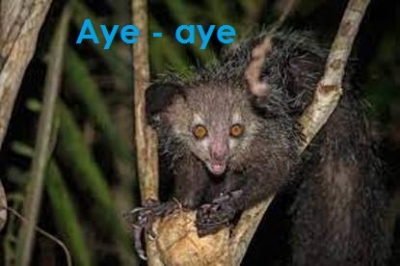
The island of Madagascar in Africa is best known for its colourful chameleons, orchids, unique flora and fauna and most importantly, its lemurs. The world’s largest nocturnal primate, the aye-aye, is one such lemur endemic to the island. Its natural habitat is rainforest but many now live in cultivated areas because of deforestation.
The aye-ayes are characterized by a distinctly long and thin middle finger and rodent-like teeth. Like the black howler monkeys, they avoid coming down from treetops and spend the daytime snuggled inside a ball-like nest made of leaves and branches.
Aye-ayes are great acoustic engineers! These avid ‘worm-eaters’ tap on tree trunks and listen carefully to the different echo patterns. This unique technique, called foraging, helps them spot the presence of wood-boring insect larvae within the empty hollows. With their middle finger, they gnaw holes into the bark and spoon out the grubs that make a happy meal.
It was Pierre Sonnerat, a French naturalist, who first used the vernacular name ‘aye-aye’ (resembling the Malagasy name ‘hay-hay’) given to this animal.
The aye-ayes are seen as evil harbingers of death by the superstitious natives of Madagascar. Ruthless slaughters of the aye-aye and deforestation practices have contributed to its decimation, giving it the ‘Endangered’ status by the IUCN.
Picture Credit : Google




